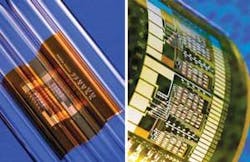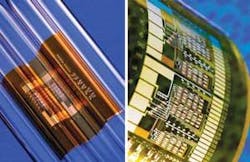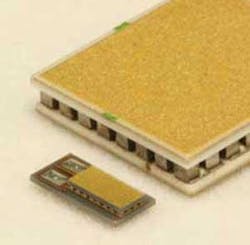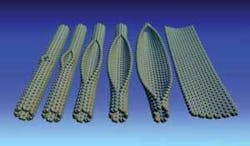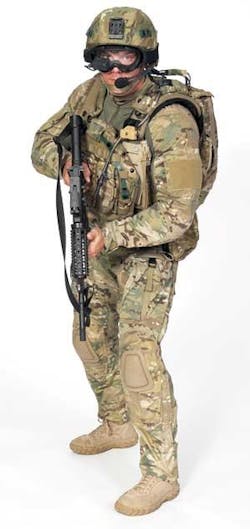Electronics miniaturization
Federal, defense, and commercial organizations partner to bring nanotechnology and microelectromechanical systems ever closer to the battlefield.
By Courtney E. Howard
Nanotechnology and microelectromechanical systems (MEMS), though small in size, are growing in functionality and adoption in military and aerospace applications. Nanotechnology and MEMS are ideal for mil-aero applications, given the increasing need for small, light weight, and low-power solutions.
“They enhance performance while reducing size and space requirements at the same time,” explains Thomas A. Jacob, regional manager of Dyconex Inc. in Mesa, Ariz. Unmanned vehicles and robotic devices will benefit perhaps first and greatest from miniaturized technology, which will enable the design of a vast amount of unmanned flying, walking, and driving robotic devices for reconnaissance sooner than later, he continues.
MEMS and nanotechnology are high priorities in the global mil-aero community, as engineers, academics, manufacturers, and government and defense personnel around the world endeavor toward miniaturized electronics innovations.
“Nanotechnology is increasingly being viewed as a competitive advantage by DOD,” says Peter Antoinette, president and CEO of Nanocomp Technologies Inc. in Concord, N.H. “The evidence is in the level of funding and increasing trend towards technology adoption.”
International investment
In the U.S., a wealth of private-sector businesses, academic institutions, and federal research-and-development laboratories are specifically focused on the advancement of MEMS and nanotechnology–many with an eye toward mil-aero environments. The Institute for Soldier Nanotechnologies at the Massachusetts Institute of Technology (MIT), founded by a $50 million contract with the U.S. Army Research Office, is a research center in Cambridge, Mass., dedicated developing nanotechnology to improve the survivability of soldiers.
At the same time, personnel at the Air Force Research Laboratory (AFRL) are furthering nanoscience and technology for military applications in the areas of directed energy weapons, optical materials, infrared photodetectors, and high-yield energetic materials for fuels and munitions.
In Switzerland, the IBM Zurich Research Laboratory and European science and engineering university ETH Zurich unveiled a $90 million, multi-year program focused on the research and engineering of “new atomic and molecular-scale structures and devices for enhancing information technologies, in dimensions below 100 nanometers (approximately 400 times thinner than a human hair),” reveals a representative.
The Russian government has set aside more than $5 billion to fund projects related to nanotechnology development. The Russian State Corp. of Nanotechnologies, the Nanotechnology Center of the Energy Institute of Moscow, the Russian Military Complex, and First Deputy Prime Minister of the Russian Government Serguei Ivanov all aim to foster the development of nanotechnology in the country. Greater development and adoption of nanotechnology, Ivanov has said, will enable the country to realize new levels of production, save energy, overcome financial hardship, and even “change the character of war” through the development of novel war materials, including weapons.
If autonomous nanobots do exist, able to take out any number of foes in a cloud-like ambush, no one is talking. Even so, a variety of technology firms continue to advance MEMS and nanotechnology for the express benefit of the mil-aero community.
Cooling at the nano scale
“Smaller, faster, cheaper, quicker is the mantra, as users seek to increase the level of functionality they have in all their devices,” explains Dr. Paul A. Magill, vice president of marketing and business development at Nextreme Thermal Solutions Inc., maker of microscale thermal and power management products for the electronics industry in Durham, N.C. “The only way to continue to improve this is with miniaturization.”
As the name implies, Nextreme Thermal Solutions is a company focused on new, miniaturized technology and devices to aid in thermal management. “All systems that do work are going to give off heat,” Magill continues. “As we put more functionality in the same space, there is more heat to deal with. We don’t want to deal with it at macro level, but at the level it is generated–and that means nanotechnology.”
Engineers at Nextreme and Princeton Lightwave Inc. (PLI), a developer of short-wave infrared (SWIR) sensors and lasers for the defense industry based in Cranbury, N.J., have jointly developed a SWIR focal plane sensor using thermoelectric cooling. The solution, based on Nextreme’s thermal bump technology and Princeton Lightwave’s Indium Gallium Arsenide (InGaAs) focal plane arrays, integrate thin-film thermoelectric coolers with focal plane arrays to enable the deployment of SWIR sensors in night-vision systems, such as night-vision goggles, weapon-sights, and laser-based ranging and tracking devices in military and homeland security applications.
Nano-scale technologies, such as that offered by Nextreme and Princeton Lightwave, are well suited to mil-aero applications in harsh environments due to the significantly reduced surface area. Whereas most active thermal electrics measure one-half to one millimeter thick, Nextreme’s microscale offerings are 5 to 20 microns thick, or roughly 1/100th to 1/400th the area.
“Most electronics are sensitive to shock and vibration and, for military applications, it’s a problem,” Magill says. “With its small size, [our solution] is inherently less susceptible to shock and vibe. Sensors and lasers used in missiles and aircraft need to take these stresses, and ours can too.”
Electro-optic efficiency
“Functionality is being driven down to the nano level,” Magill says. “You have to address heat at that level–only cool specific areas that need to be cooled, rather than use a system- or building-level solution.”
Nextreme’s OptoCooler HV14 module is a micro-scale thermoelectric cooler with broad applications on the battlefield, in the thermal management of electro-optics. “Sensors are important to target acquisition and target definition, and laser diodes are important for target painting,” Magill explains. “They allow the military to improve the accuracy of what they are doing. We offer device-level thermal management for laser diode and sensor cooling.”
Nextreme engineers are also working on supplemental human body cooling systems, through the application of nanotechnology in body armor. “Studies have shown that if you can cool the human blood, you can cool the whole body,” explains Carl Von Dutton, Nextreme’s director of marketing. “We could apply our thermo-electric technology in areas with a lot of blood flow or where arteries are close to the surface.” Embedding the company’s cooling technology in these areas of a soldier’s armor could amplify the overall cooling effects and help prevent heat stroke, he reasons.
“It is more efficient to cool a device at the source of the heat,” Von Dutton says. “The core enabling technology for Nextreme is the thermal bump, a microscopic heat pump that can be combined into larger arrays. We are working to provide that thermal heat pump directly onto a semiconductor chip. It’s about micronization.
“The flip side is that thermoelectrics can be used for power generation,” Von Dutton describes. “In one sense, they can be in a cooling and heating mode, but they can also generate small amounts of electrical power by converting heat into power.” This power-generation characteristic is garnering interest among defense officials. On one hand the nanotechnology can cool things, and on the other it can generate electricity and, for example, remotely power a wireless sensor on a network by using waste heat it is in contact with, creating green energy, he continues.
Nanotube conductivity
“Mil-aero is going to adopt nanotechnology in a big way for several compelling reasons: weight savings, alternatives to nickel and other hazardous materials, strength benefits, multi-functional applications with the same material, and comparable cost to current solutions when delivered at scale in the future,” says Nanocomp Technologies’s Antoinette.
Nanocomp Technologies fabricates long carbon nanotubes (CNTs) into strong, lightweight, electro-thermally conductive spun yarns and sheets. The goal is to create a new generation of electro-energy and thermal-management devices, as well as advanced structural materials, that have as their foundation carbon nanotubes. The company’s technology can be used in satellites, aircraft, large Navy platforms, unmanned aerial vehicles, and soldier-worn systems to deliver near-term benefits such as high conductivity and low weight, EMI and lightning protection, and high strength.
Nanocomp Technologies won a Small Business Innovation Research (SBIR) Phase I contract from the U.S. Air Force to develop very lightweight, electrically conductive wires, cables, and materials made from carbon nanotubes. Under the contract, Nanocomp engineers produced CNT sheets and spun conductors composed of long-length CNTs that surpass established electrical performance standards required by aerospace to replace traditional copper wiring, reveals a representative.
Copper wires offer excellent electrical conductivity, but they also oxidize and corrode, are susceptible to vibration fatigue, and can cause electronics failures due to overheating. Copper is also heavy; according to a Nanocomp official, “today’s large satellites weighing 15 tons or more derive one-third of their weight from copper wiring harnesses. Similarly in commercial aircraft, a Boeing 747 uses as much as 135 miles of copper wire and weighs more than 4000 pounds.” Conversely, CNTs are lightweight and conductive, making them attractive for many aerospace applications.
In April, Nanocomp won a Phase II SBIR contract from the U.S. Air Force to produce CNT wiring in the quantities and forms required for direct integration into aircraft electric power applications.
“It is generally overlooked that modern satellites and aircraft rely on an invention from the 1800s–copper-based electrical wires and cables,” Antoinette says. “Our work can result in a true 21st century change in the game, creating electrically optimized carbon nanotube wires and cables, comparable to copper in terms of electrical conductivity but up to 80 percent lighter and more robust. The result will be increased mission capability for the Air Force and dramatic fuel savings for the entire aerospace industry.”
Sheets for shielding
Nanocomp Technologies engineers have produced 3x6-foot sheets of carbon nanotube material, which company officials describe as a milestone in nanotube growth technology and the largest cohesive sheets of nanotube material ever produced.
Based on this development, U.S. Air Force officials have again called on Nanocomp technology. They issued a Phase I SBIR contract for the development of carbon nanotube mats as a substitute for nickel-based conductors in electrostatic discharge (ESD) and electromagnetic interference (EMI) shielding applications. Designated a “critical program” by the U.S. government, says a company official, the research is intended to optimize CNT sheet materials to meet shielding requirements and to integrate the mats into existing commercial EMI/ESD shielding systems.
“The nature and importance of these projects demonstrates the unique potential of our material as the basis for creating game-changing yet cost-effective replacements for traditional aerospace components,” adds Antoinette.
Nanocomp’s materials are designed to provide a high strength-to-weight ratio, electrical and thermal conductivity, and flame resistance for such applications as EMI shielding, electrical conductors, thermal dissipation solutions, lightning protection, and advanced structural composites.
Aircraft lightning strike protection
Military and commercial engineers have combined efforts to produce electrically conductive structural composites, polymers, paints, adhesives, and ceramics by combining nickel nanostrands of 100 to 150 nanometers in diameter and up to a millimeter in length for various military applications. The research–by engineers at the Air Force Research Laboratory Materials and Manufacturing Directorate, the Metal Matrix Composites Company LLC in Heber City, Utah, and Eclipse Composite Engineering in Herriman, Utah–was funded by an Air Force SBIR program.
Component-level testing indicates that composite structures with nickel nanostrands provide significant protection from lightning strike damage, required for all-weather aircraft operation. “Commercial aircraft are struck by lighting one to two times a year, and all-weather operation required for military aircraft increases the chance of a lightning strike,” says an AFRL official.
Conductive polymers using nickel nanostrands are also being validated for the shielding of electronic components from electromagnetic pulses (EMPs); if effective, these polymers can reduce a single aircraft’s weight by 150 pounds when compared to current metal shielding.
Flexible electronics
Scientists at Rice University in Houston developed a chemical process that splits carbon nanotubes to produce ultrathin, flat nanoribbons in large quantities. These straight-edged, water-soluble sheets of grapheme can be used to create elements for aircraft and electronics that incorporate sheets of tough, electrically conductive material. “You’d have to place thousands of them side by side to equal the width of a human hair, but tests show graphene is 200 times stronger than steel,” says a representative. In bulk, these microscopic sheets can be “painted” onto a surface or combined with a polymer to conduct electricity.
Rice University professor James Tour is excited by the possibility that conductive nanoribbons could replace indium tin oxide (ITO), reveals a representative. ITO is used in flat-panel displays, touch panels, electronic ink, and solar cells. “ITO is very expensive, so lots of people are looking for substitutes that will give them transparency with conductivity,” he said. He also envisions nanoribbon-coated paper used as a flexible electronic display. “We’re printing transistors and radio-frequency identification tags–printing electronics with these inks. This is going to be the new material for many applications.”
This work was funded by the Defense Advanced Research Projects Agency (DARPA), the Federal Aviation Administration (FAA), and Wright Patterson Air Force Laboratory through the U.S. Air Force Office of Scientific Research.
The U.S. Air Force has logged yet another milestone in the use of nanotechnology for flexible electronics, this time for surveillance radar applications. Professors at the University of Wisconsin-Madison in Madison, Wis., in partnership with the Air Force Research Laboratory Nanoscience and Technology Strategic Technology Team, harnessed silicon nanomembranes to produce fast, flexible electronic devices.
“Created specifically for Air Force missions, these high-speed, flexible electronics enable large-area, conformal radio-frequency surveillance radar in manned and unmanned aircraft and in spacecraft,” reveals an AFRL official. “Thin electronic circuits on flexible polymer substrates offer dramatic advancements in airborne (manned or unmanned) and spaceborne surveillance radars essential to the Air Force and to national security.”
Compared to conventional rigid-chip systems, these nanomembrane-based electronics are thinner and more flexible, making them a viable choice for missiles, rockets, and smart bombs, which suffer space constraints and extreme vibration. They also enable attachment to irregular surfaces, mounting in limited space, and resistance to damage from impact and vibration. The nanotechnology solution features a large active area that improves the radar signal, and offers a reduction in the aerodynamic weight, drag, complexity, and cost associated with most protruding radar antennae. An unnamed U.S. aerospace manufacturer is evaluating its application to conformal radio-frequency antennae on next-generation military aircraft.
This accomplishment was achieved by prof. Zhenqiang Ma and prof. Max Lagally at the University of Wisconsin-Madison. Funds were provided by the Air Force Nanotechnology Initiative Program at the Air Force Office of Scientific Research.
Nanobattery news
Warfighters on today’s digital battlefield know well the value of reliable battery power in their packs, but they are also keenly aware of the weight burden this represents. For this reason, various nanotechnology firms are working to perfect nanobatteries, and defense organizations are funding the research and development.
Officials at the U.S. Army Research Office issued a Phase II Small Business Technology Transfer (STTR) grant, part of the SBIR program, to mPhase Technologies Inc., a nanotechnology development company in Little Falls, N.J., to produce a miniature, long-life battery for powering computer memory chips.
mPhase engineers are continuing development of a reserve Smart NanoBattery for this critical computer memory application. Under its Phase I grant, they developed a “green,” low-power battery capable of continuously powering a static random access memory circuit for a computer device. Phase II work will center on refining the technology into a small footprint, multi-cell, 3-volt, lithium chemistry micro-arrayed battery with a minimum 20-year shelf life and uninterruptible power output during this period, explains a company representative.
Engineers at mPhase/AlwaysReady teamed with personnel at Energy Storage Research Group (ESRG) at Rutgers, The State University of New Jersey, for both phases of this project to develop the Smart NanoBattery for the U.S. Army’s SRAM backup application.
In April, mPhase publicly unveiled the first Smart NanoBattery packaging prototype developed as part of the U.S. Army STTR program: the AlwaysReady Emergency Flashlight.
The Smart Nanobattery’s multiple cell and silicon-based membrane design will potentially provide constant power to devices, such as the flashlight, for 20 years.
“It’s really great to see this project coming together in a tangible form,” mPhase CEO Ron Durando says. “With each step forward, we are making accomplishments that have never been seen before in the nanotechnology community.”
MEMS snapshot
Microelectromechanical systems (MEMS) are perhaps best defined by the MEMS and Nanotechnology Clearinghouse in Reston, Va., as “the integration of mechanical elements, sensors, actuators, and electronics on a common silicon substrate through microfabrication technology.” MEMS are reactive devices, which translate an event into usable data.
“Military departments most interested in MEMS seem to be involved in ‘on-body medical awareness,’” observes Robert Stanton, director of technology at Omnetics Connector Corp., a designer and manufacturer of micro and nano miniature interconnect products in Minneapolis. “MEMS have done well in the biochemical field (also called biotechnology).”
Engineers at the Natick Army Soldier Center in Natick, Mass., are employing MEMS in their innovative work on future warrior technologies. Using electronics to communicate the health of soldiers in the field, the Warrior Physiological Status Monitoring System (WPSM) is a system of sensors distributed throughout a uniform worn by the soldier that monitors diastolic and systolic information, core body and skin temperatures, and heart rate. Reactive MEMS can convey to medics whether a soldier has suffered a ballistic trauma, for example, and where on the body.
MEMS technology and device development have historically been well funded by governments such as that in the U.S. “Omnetics has had calls for its Nano-cable and Connector interconnects to power and to provide output data for MEMs systems,” Stanton reveals. “Omnetics supplies some of the smallest connectors with some of the most flexible wiring in the world, and they come to us for that kind of support.”
For more information, visit Omnetics and the Natick Soldier Center online at www.omnetics.com and www.natick.army.mil, respectively.
MEMS-based GPS
Engineers at Seer Technology Inc. in Salt Lake City, Utah, have unveiled a MEMS-based personal navigation system, the NaviSeer, for military and security applications.
“NaviSeer uses advanced MEMS technology to provide a lightweight and compact wearable unit so that exact locations of personnel are always visible,” Kent Garland, NaviSeer’s product manager, explains. “A field commander can constantly see all personnel and make educated critical decisions in harsh and GPS denied environments.”
NaviSeer is intended to integrate with military and commercial GPS communication systems to deliver personnel positioning information. The compact unit sits on the wearer’s back, translates body movements into latitude, longitude, and elevation digital position data, which is communicated to the command-and-control center.
For more information, visit Seer Technology online at www.seertechnology.com.
